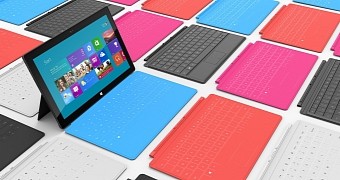Microsoft's new Windows 10 operating system will continue to be available free of charge for devices with small screens, in an attempt to bring more tablets and smartphones running the new software to the market, but the company is also preparing its very own offensive for the hardware business.
A new report reveals that, as part of its efforts to stop the rapid growth of Chromebooks, Microsoft is working to bring to the market a new Surface model, that would be specifically designed to be much more affordable than previous versions.
Strangely enough, most Microsoft models have been extremely pricey until now, and the Surface Pro 3, for example, can be purchased for $1,950 (€1,500) in top configuration, so the tech giant didn't seem to be interested in budget models at all in the past.
And yet, the company could adopt a completely different strategy for the next few years, as it wants not only to boost adoption of Windows 10 but also to become more relevant in a market that's still dominated by Android and iOS.
The new affordable Surface model could come with a 10.6-inch display, just like the pre-Surface Pro 3 versions, and might be offered in the same 2-in-1 configuration as the others, so a removable keyboard will continue to be a key feature.
Likely to launch in late 2015
There are no pricing details right now, but if Microsoft indeed plans to step in the budget tablet industry, expect its device to ship for around $250 or $300 (€220 or €245) when it hits the market.
Pricing could obviously go up as you opt for more powerful hardware, but the main purpose of the new device is to remain very affordable no matter what version you choose.
As far as technical specs are concerned, there's no rumor as of yet but Microsoft would most likely want the device to run the full version of Windows 10, so at least 1 GB (32-bit) or 2 GB (64-bit) and a processor of 1 GHz are needed.
Windows 10 also requires 16 GB of free hard disk space, so a minimum of 32 GB of storage space, probably coupled with microSD card support and free OneDrive plans for a limited time, would be offered.
Contradictory rumors
And while at some level it makes sense for Microsoft to look at the budget tablet industry, these rumors do not align with previous speculation regarding Redmond's plans for the Surface lineup.
Microsoft was initially believed to be working on two different Surface models, namely a Surface 4 (or Surface Pro 4) and a Surface Mini.
The Surface 4 was expected to be the successor to Surface Pro 3 and come with a 12-inch display and powerful hardware that would make it a laptop replacement in all regards. The Surface Mini was said to come in the form of a note-taking device with an 8-inch display and appeal to teachers and students who want to replace the traditional notebook and work mostly with a digital pen.
Both these devices were expected to arrive in the late of 2015, after the release of Windows 10, so all rumors point pretty much to the same launch date.
As usual, Microsoft doesn't wish to comment on speculation, so our only option for now is to wait and see how the company plans to become relevant in the tablet sector.

 14 DAY TRIAL //
14 DAY TRIAL //